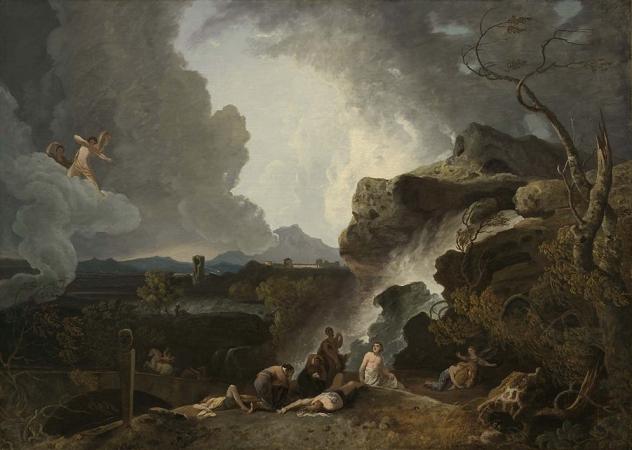
Richard Wilson. Richard Wilson was an influential Welsh landscape painter, who worked in Britain and Italy.
With George Lambert he is recognised as a pioneer in British art of landscape for its own sake and was described in the Welsh Academy Encyclopedia of Wales as the most distinguished painter Wales has ever produced and the first to appreciate the aesthetic possibilities of his country. In December 1768 Wilson became one of the founder-members of the Royal Academy.
A catalogue raisonné of the artist's work compiled by Paul Spencer-Longhurst is published by the Paul Mellon Centre for Studies in British Art. The son of a clergyman, Richard Wilson was born on 1 August 1714, in the village of Penegoes in Montgomeryshire.
The family was an established one, and Wilson was first cousin to Charles Pratt, 1st Earl Camden. In 1729 he went to London, where he began as a portrait painter, under the apprenticeship of an obscure artist, Thomas Wright.
Wilson could often be found walking around Marylebone Gardens with his acquaintance Baretti heading toward the Farthing Pie House, now known as the Greene Man. From 1750 to 1757 Wilson was in Italy, and became a landscape painter on the advice of Francesco Zuccarelli. Painting in Italy and afterwards in Britain, he was the first major British painter to concentrate on landscape. He composed well, but saw and rendered only the general effects of nature, the
With George Lambert he is recognised as a pioneer in British art of landscape for its own sake and was described in the Welsh Academy Encyclopedia of Wales as the most distinguished painter Wales has ever produced and the first to appreciate the aesthetic possibilities of his country. In December 1768 Wilson became one of the founder-members of the Royal Academy.
A catalogue raisonné of the artist's work compiled by Paul Spencer-Longhurst is published by the Paul Mellon Centre for Studies in British Art. The son of a clergyman, Richard Wilson was born on 1 August 1714, in the village of Penegoes in Montgomeryshire.
The family was an established one, and Wilson was first cousin to Charles Pratt, 1st Earl Camden. In 1729 he went to London, where he began as a portrait painter, under the apprenticeship of an obscure artist, Thomas Wright.
Wilson could often be found walking around Marylebone Gardens with his acquaintance Baretti heading toward the Farthing Pie House, now known as the Greene Man. From 1750 to 1757 Wilson was in Italy, and became a landscape painter on the advice of Francesco Zuccarelli. Painting in Italy and afterwards in Britain, he was the first major British painter to concentrate on landscape. He composed well, but saw and rendered only the general effects of nature, the
Wikipedia ...